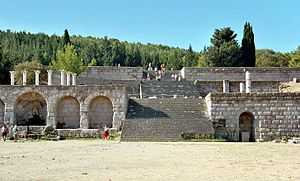Asclepeion
In ancient Greece and Rome, an asclepeion (Ancient Greek: Ἀσκληπιεῖον Asklepieion; Ἀσκλαπιεῖον in Doric dialect; Latin aesculapīum) was a healing temple, sacred to the god Asclepius.

Asclepius may first have been worshipped as a hero in Trikka, Thessaly, which ancient mythographers generally regarded as the place of his birth, but to date archaeological excavations have yet to uncover his sanctuary there.[1][2] Epidauros, on the other hand, was the first place to worship Asclepius as a god, beginning sometime in the 5th century BC. The asclepieion at Epidaurus is both extensive and well preserved. There is an asclepieion located on the south slopes of the Acropolis of Athens which dates to around 420 BC.
Starting around 350 BC, the cult of Asclepius became increasingly popular. Pilgrims flocked to asclepieia to be healed. They slept overnight ("incubation") and reported their dreams to a priest the following day. He prescribed a cure, often a visit to the baths or a gymnasium. Since snakes were sacred to Asclepius, they were often used in healing rituals. Non-venomous snakes were left to crawl on the floor in dormitories where the sick and injured slept.
Asclepeia provided carefully controlled spaces conducive to healing and fulfilled several of the requirements of institutions created for healing.[3] In the Asclepieion of Epidaurus, three large marble boards dated to 350 BC preserve the names, case histories, complaints, and cures of about 70 patients who came to the temple with a problem and shed it there. Some of the surgical cures listed, such as the opening of an abdominal abscess or the removal of traumatic foreign material, are realistic enough to have taken place, but with the patient in a dream-like state of induced sleep known as "enkoimesis" (Greek: ἐγκοίμησις) not unlike anesthesia, induced with the help of soporific substances such as opium.[4]
Pausanias remarked that, at the asclepieion of Titane in Sicyon (founded by Alexanor, Asclepius' grandson), statues of Hygieia were covered by women's hair and pieces of Babylonian clothes. According to inscriptions, the same sacrifices were offered at Paros.
Hippocrates is said to have received his medical training at an asclepieion on the isle of Kos. Prior to becoming the personal physician to the Roman Emperor Marcus Aurelius, Galen treated and studied at the famed asclepieion at Pergamon.

See also
References
- ↑ Edelstein, E. J. and L. L. Edelstein. Asclepius: a collection and interpretation of the testimonies. 2 vols. The Publications of the Institute of the History of Medicine. (Baltimore, 1945): 243.
- ↑ MELFI, M. I santuari di Asclepio in Grecia. 2 vols. Studia Archaeologica 157 (Rome, 2007): 511.
- ↑ Risse, G.B. Mending bodies, saving souls: a history of hospitals. Oxford University Press, 1990. p. 56
- ↑ Askitopoulou, H, Konsolaki, E, Ramoutsaki, I, Anastassaki, E. Surgical cures by sleep induction as the Asclepieion of Epidaurus. The history of anesthesia: proceedings of the Fifth International Symposium, by José Carlos Diz, Avelino Franco, Douglas R. Bacon, J. Rupreht, Julián Alvarez. Elsevier Science B.V, International Congress Series 1242(2002), pp. 11–17.
External links
| Wikimedia Commons has media related to Temples of Asclepius. |
- Ministry of Culture/ Asclepeion of Epidaurus
- Asclepeion of Pautaliya
- Ministry of Culture/ Asclepion of Trikala
- Presentation of Tholos - The Asclepieion at Epidaurus (click "Presentation")